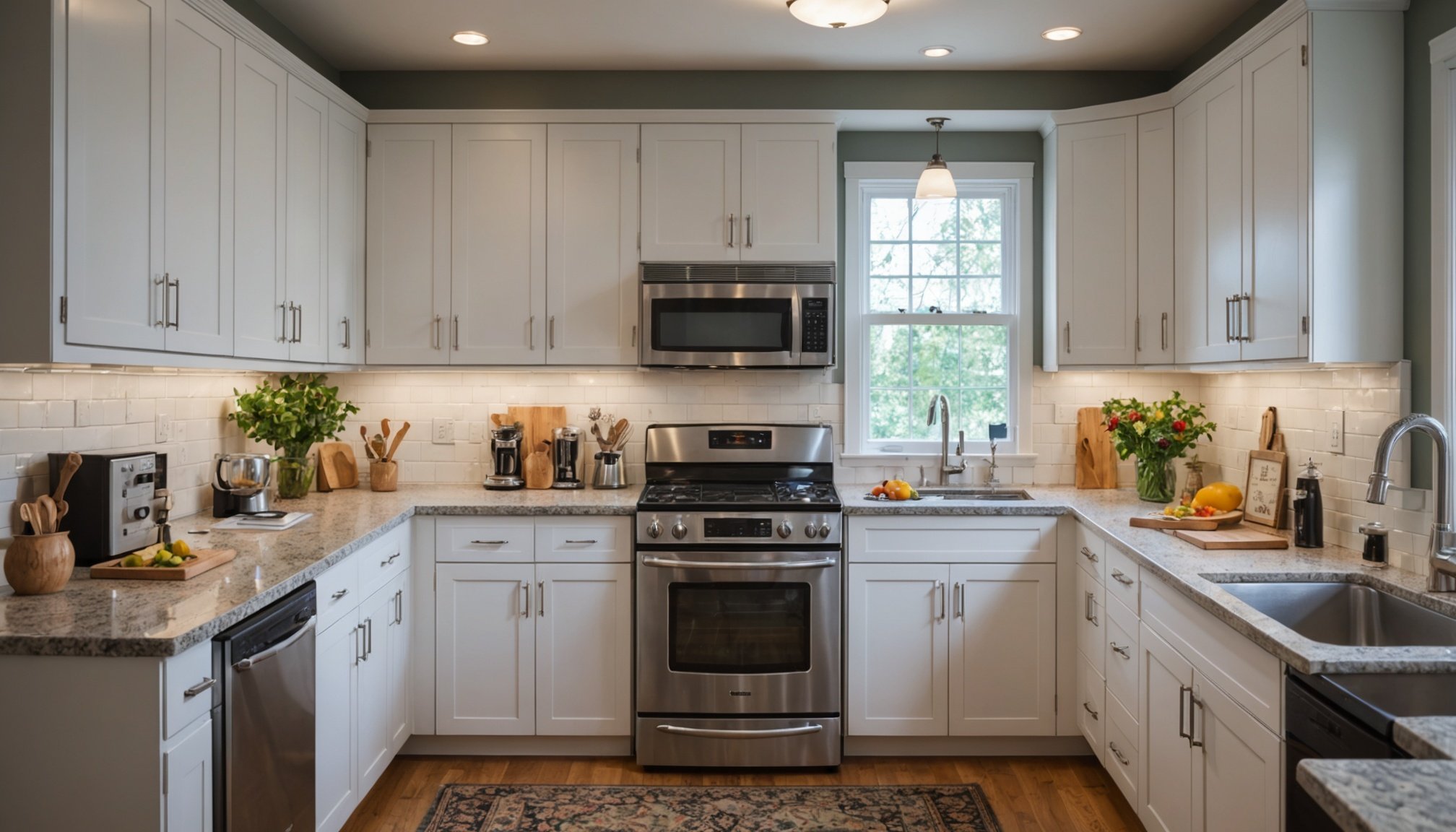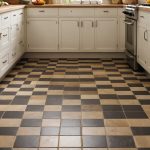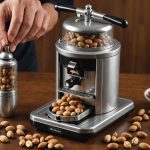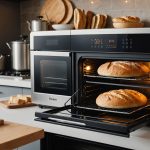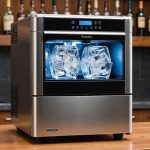Transforming your kitchen into an energy-efficient space doesn’t require a complete overhaul. Small, thoughtful changes can lead to significant savings on your electric bill. By adopting smart strategies for using electric appliances, you can reduce consumption while enjoying your culinary activities. Explore practical tips that enhance efficiency, all while maintaining the functionality and comfort of your kitchen. Embrace these insights to create a sustainable environment, benefiting you and the planet.
Understanding Energy Efficiency in the Kitchen
Exploring how to make your kitchen more sustainable and cost-effective.
In parallel : Crafting a Kitchen Oasis: Designing Your Ideal Fermentation Station
Importance of Energy Efficiency
Energy efficiency in the kitchen is crucial for both environmental and financial reasons. It refers to using less energy to perform the same tasks, which can significantly reduce electricity bills and carbon footprints. With increasing awareness of sustainability, more households are seeking ways to make their kitchens more energy-efficient. This not only helps in conserving resources but also contributes to a healthier planet.
Benefits of an Energy-Efficient Kitchen
An energy-efficient kitchen offers numerous advantages. It reduces energy consumption, leading to lower utility costs. Additionally, it enhances the lifespan of kitchen appliances, as they operate more effectively and with less strain. By investing in energy-efficient technologies, households can create a more sustainable living environment.
Also read : Transforming your kitchen: creative strategies for an allergen-free and healthier home
Energy Consumption in Typical Kitchens
Typical kitchens consume a substantial amount of energy due to the variety of appliances used. Refrigerators, ovens, and dishwashers are among the top energy consumers. Understanding the energy usage of these appliances can help in identifying areas for improvement.
- Refrigerators: 20-30% of kitchen energy use
- Ovens: 10-15%
- Dishwashers: 5-10%
Implementing energy-efficient practices can lead to significant savings and a more sustainable kitchen environment.
Selecting Energy-Efficient Appliances
Choosing the right energy-efficient appliances is essential for reducing energy consumption in your kitchen.
Understanding Appliance Ratings
When selecting appliances, it's crucial to understand energy ratings. Labels like Energy Star provide a clear indication of an appliance's efficiency. These ratings help consumers compare the energy consumption of similar products. For instance, an Energy Star-rated refrigerator uses up to 15% less energy than non-rated models. This translates to significant savings over time.
Comparing Energy Consumption
To make informed decisions, compare the energy usage of popular kitchen appliances. Many brands offer detailed consumption data, allowing for side-by-side evaluations. Consider the following when comparing:
- Refrigerators: Look for models with inverter compressors.
- Ovens: Opt for convection models, which use less energy.
- Dishwashers: Choose those with eco-wash settings.
Recommendations for Top Brands
Selecting top energy-efficient brands can further enhance your kitchen's sustainability. Brands like Bosch, LG, and Samsung are renowned for their eco-friendly designs and advanced technologies. These companies offer a range of products that consistently receive high appliance ratings for efficiency and performance.
By focusing on these elements, you can create a more sustainable and cost-effective kitchen environment.
Optimal Appliance Usage Strategies
Enhancing energy efficiency through smart appliance usage.
Best Practices for Major Appliances
To maximize energy savings, it's essential to adopt best practices for appliance usage. For refrigerators, ensure they are placed away from heat sources and maintain a consistent temperature setting. Regularly defrost and keep the coils clean to enhance efficiency. When using ovens, preheat only when necessary and use the right-sized cookware to match the burner. This ensures even cooking and reduces energy waste.
Cooking Techniques for Energy Efficiency
Adopting smart cooking techniques can further enhance energy efficiency. Utilize lids on pots to retain heat and reduce cooking time. Opt for pressure cookers or slow cookers, which use less energy compared to traditional methods. Whenever possible, cook in larger batches to minimize the frequency of appliance use.
Scheduling Appliance Use
Consider scheduling your appliance usage during off-peak hours when electricity rates may be lower. This is particularly beneficial for energy-intensive tasks like dishwashing and laundry. Many modern appliances come with timers or delay start features, allowing for convenient scheduling.
- Refrigerators: Maintain consistent settings
- Ovens: Use appropriate cookware
- Cooking: Batch cook to save energy
Implementing these strategies can significantly contribute to a more efficient and sustainable kitchen environment.
Smart Home Technology for Efficiency
Harnessing the power of smart home systems for a sustainable kitchen.
Overview of Smart Appliances
Smart home technology is revolutionizing energy management in the kitchen. Smart appliances offer advanced features that enhance efficiency and convenience. For instance, smart refrigerators can monitor and adjust their internal temperature based on usage patterns. This ensures optimal energy consumption.
Integration of Smart Home Systems
Integrating smart home systems allows for comprehensive energy management. These systems can monitor and control various appliances, providing real-time data on energy usage. By automating functions like turning off lights or adjusting thermostat settings, homeowners can significantly reduce energy waste.
- Smart Thermostats: Adjust heating/cooling based on occupancy.
- Smart Lighting: Automatically dims or turns off when not needed.
- Smart Plugs: Schedule appliance use to off-peak hours.
Examples of Energy-Saving Gadgets
Several energy-saving gadgets can further enhance kitchen efficiency. Devices like smart plugs and energy monitors allow for precise control and monitoring of energy usage. By utilizing these tools, homeowners can identify high-energy appliances and adjust their usage accordingly. This proactive approach to energy management not only reduces costs but also contributes to a more sustainable kitchen environment.
Kitchen Layout for Energy Efficiency
Optimizing your kitchen design for better energy management and workflow.
Importance of Kitchen Layout in Energy Consumption
An efficient kitchen layout significantly influences energy consumption. By strategically organizing appliances and workspaces, you can reduce unnecessary energy use. For example, placing the refrigerator away from heat sources like ovens minimizes energy strain. This thoughtful arrangement not only enhances energy efficiency but also improves the overall workflow.
Suggestions for Designing an Energy-Efficient Kitchen
Designing a kitchen with energy efficiency in mind involves considering the layout and placement of key appliances. A well-planned kitchen design can streamline tasks and reduce energy waste. Consider the following layout strategies:
- Triangle Work Zone: Position the sink, stove, and refrigerator in a triangle to minimize movement.
- Zoning Appliances: Group appliances by function to reduce energy transfer and improve efficiency.
- Natural Lighting: Maximize daylight to reduce reliance on artificial lighting.
Tips for Organizing Appliances and Workspaces
Organizing appliances and workspaces effectively is crucial for an energy-efficient kitchen. Ensure that frequently used items are easily accessible to reduce time and energy spent searching. Use shelving and cabinetry to optimize storage and keep countertops clear, promoting a more efficient workflow. By focusing on these aspects, you can create a kitchen that is both energy-efficient and user-friendly.
Maintenance Practices for Appliances
Ensuring efficiency and extending appliance lifespan through proper care.
Importance of Regular Maintenance for Energy Efficiency
Regular appliance maintenance is essential for sustaining energy efficiency and prolonging the life of kitchen devices. Proper upkeep ensures that appliances operate at peak performance, reducing unnecessary energy consumption. For instance, cleaning refrigerator coils can enhance cooling efficiency, thereby lowering energy bills.
Tips for Cleaning and Maintaining Key Kitchen Appliances
To maintain appliance longevity, follow these essential cleaning tips:
- Refrigerators: Clean coils and check door seals regularly.
- Ovens: Use self-cleaning features and wipe spills promptly.
- Dishwashers: Clear filters and run cleaning cycles monthly.
Consistent maintenance not only improves efficiency but also prevents costly repairs.
Signs That Indicate Appliances Need Servicing or Replacement
Recognizing when appliances need attention is crucial. Look out for these signs:
- Increased Energy Bills: May indicate inefficiency.
- Unusual Noises: Could signal mechanical issues.
- Poor Performance: Suggests potential failure.
Addressing these signs promptly can prevent further damage and ensure appliances remain efficient. By prioritizing appliance maintenance, homeowners can enjoy a more sustainable kitchen environment, reducing both energy consumption and costs.
Innovative Energy-Saving Cooking Techniques
Exploring smart ways to conserve energy while cooking.
Utilizing Advanced Cooking Methods
Incorporating energy-saving cooking techniques can significantly reduce energy consumption. Pressure cookers, slow cookers, and induction cooktops are excellent tools for efficient cooking. Pressure cookers reduce cooking time by up to 70%, while slow cookers use less energy than conventional ovens. Induction cooktops offer precise temperature control, ensuring minimal energy waste.
Batch Cooking and Meal Prep Strategies
Batch cooking is a practical approach to save energy. By preparing large quantities of food in one session, you minimize the frequency of appliance use. This method is not only energy-efficient but also time-saving. Consider preparing meals for the week in advance, storing them in portions. This reduces daily cooking time and energy use.
- Plan meals weekly to streamline cooking
- Use large pots to cook multiple servings
- Store meals in reusable containers for convenience
Energy-Efficient Meal Planning Tips
Thoughtful meal planning contributes to energy conservation. Choose recipes that utilize energy-efficient appliances and techniques. For example, opt for dishes that can be cooked simultaneously in a slow cooker. Incorporate salads and no-cook meals to further reduce energy use. By adopting these strategies, you can enjoy delicious meals while conserving energy.
Evaluating the Cost Savings of Energy Efficiency
Analyzing financial benefits through strategic energy efficiency investments.
Initial Investment vs. Long-Term Savings
Investing in energy-efficient appliances can initially seem daunting due to higher upfront costs. However, the long-term cost savings on energy bills often outweigh these initial expenses. For instance, a modern energy-efficient refrigerator might cost more initially, but its reduced energy consumption can lead to significant savings over its lifespan.
Case Studies of Cost Savings
Consider the following examples that highlight the financial benefits of energy-efficient changes:
- Family A: Upgraded to energy-efficient appliances, saving 25% on annual energy bills.
- Business B: Retrofitted their kitchen with eco-friendly devices, reducing energy costs by 30%.
- Household C: Implemented smart home systems, achieving a 20% decrease in electricity expenses.
Budgeting for Energy-Efficient Appliances
Planning for the purchase of budget-friendly energy-efficient appliances involves strategic budgeting. Start by identifying high-energy consuming devices in your kitchen. Allocate funds gradually for replacements. Consider financing options or government incentives that support sustainable choices. By prioritizing these investments, you can enjoy substantial cost savings while contributing to environmental sustainability.
Community Resources and Incentives
Exploring opportunities for sustainable living through community support.
Overview of Local and National Energy Efficiency Programs
Local and national energy efficiency programs offer valuable resources for households aiming to reduce energy consumption. These programs often provide guidance on adopting energy-efficient practices and technologies. For example, the U.S. Department of Energy offers initiatives that help communities enhance their energy use. Participating in these programs can lead to significant cost savings and environmental benefits.
Finding Rebates or Incentives for Energy-Efficient Appliances
Securing rebates and incentives for purchasing energy-efficient appliances is a practical way to offset initial costs. Many utility companies and government bodies offer financial incentives to encourage sustainable choices. To find these opportunities, check with local energy providers or visit government websites dedicated to energy efficiency. These incentives can make a substantial difference in your budget.
- Utility Company Rebates: Check local providers
- Government Incentives: Explore federal and state programs
- Retailer Discounts: Inquire about store promotions
Community Initiatives Promoting Sustainable Living
Community initiatives play a crucial role in promoting sustainable living. Neighborhood associations and local governments often organize events and workshops focused on energy conservation. These initiatives foster a culture of sustainability and provide practical solutions for reducing energy use. Engaging with these community resources can enhance your household's energy efficiency efforts.
Future Trends in Energy-Efficient Kitchens
Exploring sustainable technology and kitchen innovation for the future.
Emerging Technologies in Kitchen Appliances
The future of energy-efficient kitchens is being shaped by cutting-edge technologies. Innovations such as smart sensors and AI-driven appliances are set to revolutionize kitchen efficiency. These technologies can optimize energy use by learning user habits and adjusting operations accordingly. For instance, smart refrigerators that adjust cooling based on contents and usage patterns highlight the trend towards sustainable technology.
Predictions for the Future of Energy Efficiency in Homes
As consumer awareness grows, the demand for sustainable technology in kitchens is expected to rise. Future homes will likely feature integrated systems that monitor and manage energy use seamlessly. Energy-efficient innovations will become standard, with appliances communicating to optimize performance. This trend is driven by both technological advances and consumer preferences for environmentally friendly solutions.
How Consumer Preferences Are Shaping Energy-Efficient Innovations
Consumer demand for sustainable technology is a key driver of kitchen innovation. Preferences for eco-friendly products are pushing manufacturers to develop more efficient appliances. A focus on reducing carbon footprints and utility bills is influencing the design of future kitchens.
- Smart Sensors: Enhance appliance efficiency
- AI Technology: Learns and adapts to user habits
- Eco-Friendly Designs: Prioritize sustainability
These trends illustrate the evolving landscape of energy-efficient kitchens, promising a future where technology and sustainability go hand in hand.

